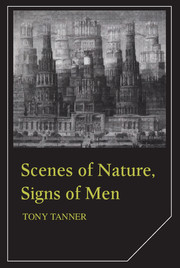Book contents
- Frontmatter
- Contents
- Preface
- 1 Scenes of nature, signs of men
- 2 Notes for a comparison between American and European Romanticism
- 3 Problems and roles of the American artist as portrayed by the American novelist
- 4 James on Hawthorne
- 5 The lost America – the despair of Henry Adams and Mark Twain
- 6 Henry James and Henry Adams
- 7 William Dean Howells and A Hazard of New Fortunes
- 8 Stephen Crane
- 9 The Bostonians and the human voice
- 10 Games American writers play: ceremony, complicity, contestation, and carnival
- 11 Toward an ultimate topography: the work of Joseph McElroy
- 12 Frames and sentences
- 13 William Gass's barns and bees
- Index
2 - Notes for a comparison between American and European Romanticism
Published online by Cambridge University Press: 01 June 2011
- Frontmatter
- Contents
- Preface
- 1 Scenes of nature, signs of men
- 2 Notes for a comparison between American and European Romanticism
- 3 Problems and roles of the American artist as portrayed by the American novelist
- 4 James on Hawthorne
- 5 The lost America – the despair of Henry Adams and Mark Twain
- 6 Henry James and Henry Adams
- 7 William Dean Howells and A Hazard of New Fortunes
- 8 Stephen Crane
- 9 The Bostonians and the human voice
- 10 Games American writers play: ceremony, complicity, contestation, and carnival
- 11 Toward an ultimate topography: the work of Joseph McElroy
- 12 Frames and sentences
- 13 William Gass's barns and bees
- Index
Summary
Animals have often provided Romantic writers with important images. Blake's tiger and Melville's whale are both used to focus on the awesome and ambiguous energies at the heart of creation. Insects, too, have often been invoked for the purposes of emulation or identification. Words-worth gathers visual pleasures ‘like a bee among the flowers’; Emerson admires the ‘Humble-Bee’ in his ‘sunny solitudes’:
Sailor of the atmosphere;
Swimmer through the waves of air;
Voyager of light and noon;
Emily Dickinson cries ‘Oh, for a bee's experience / Of clovers and of noon’; Rilke writes ‘We are the bees of the Invisible. Nous butinons éperdument le miel du Visible pour l'accumuler dans la grande ruche d'or de l'invisible.’ It is an attractive and understandable image for any Romantic writer who seeks to assimilate the pollen of perception in order to transmute it into the honey of his art. But more unusual perhaps is the attraction which the spider has held for American writers from Jonathan Edwards to Robert Lowell. Thus Edwards starts one of his earliest pieces of writing, ‘Of Insects’: ‘Of all Insects no one is more wonderfull than the Spider especially with Respect to their sagacity and admirable way of working.’ Edwards was particularly struck to see spiders apparently ‘swimming in the air’ (like Emerson's bee), and he describes how he watched and experimented to see how they managed to sustain themselves in space.
- Type
- Chapter
- Information
- Scenes of Nature, Signs of MenEssays on 19th and 20th Century American Literature, pp. 25 - 45Publisher: Cambridge University PressPrint publication year: 1987

